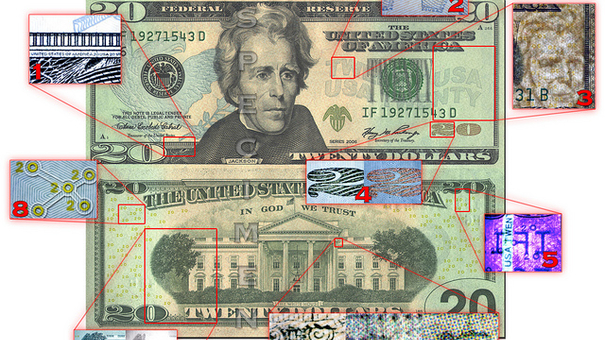Nowadays, there has been a surge in the number of reported cases involving counterfeit money worldwide. Although counterfeit money resembles original currency, it is possible to differentiate it from the real money using bill detectors or by studying a few physical characteristics of the bill texture, colours, inks or by passing it through a special scanner that is designed purposely for detecting counterfeit money.
There are millions of dollars of counterfeit money circulating in different markets. This article is meant to enlighten people, especially business owners, with the knowledge to differentiate unauthentic bills from authentic ones.
Counterfeit currency is no longer a concern for enterprises that accept credit card payments only.
How to Detect Counterfeit Money?
Counterfeiters at times, match a few security features, but not all of them. By taking into account these security features, it will be easy to tell a counterfeit bill. They include:
Colour Shifting Ink
The first step to tell whether a bill is counterfeit is to study the bill denomination on the bottom right-hand corner to find out whether it has the right colour shifting ink or not. If it displays this feature, then proceed to other security features; otherwise, it is unauthentic.
Elevated Printing
Every authentic US reserve note has a raised printing. More often, counterfeiters find it hard to duplicate this kind of printing strategy. This makes it easy to distinguish counterfeit from unauthentic monies.
Blurry Borders
If you spot considerably blurry borders or texts, then you need to be worried. Authentic monies are expansively explicit, designed using die-cut printing plates with the potential to make notable fine lines. With printers, it is impossible to generate impressive fine lines. Borders made up using printers are usually blurred, and this helps people to detect unauthentic bills with ease.
Another key feature to take into consideration is micro-printing. Undisputed bills have a precise text found at various sections on the bill. Most of the counterfeiters lack sophisticated printing equipment with the potential to duplicate micro-printing as it is in authentic currencies. In addition, you can quickly tell whether the micro-printing is authentic by subjecting the bill to some form of magnification. If you find it readable, then it is authentic; otherwise, counterfeit.
Watermark
Watermark is another security feature that can help you to detect a counterfeit bill. In many instances involving new bills, the water and the face on the bill are alike. Some have an oval spot. However, keep in mind the following things when examining a watermark.
The watermark should only be seen when exposed to the light.
It is only found on the right side of the currency.
In case of a face, the watermark should resemble the face on the currency.
Unavailability of watermark or if it is visible without being exposed to the light, then the bill is probably a counterfeit.
Serial Numbers Should Replicate the Printing Year/Series
The serial numbers in an authentic bill correspond to the probable series/run year printed on the currency. It is important to note that each letter that a serial number begins with matches a specific year.
We hope that the discussed above can help you determine whether the bill is authentic or counterfeit.
![[OL TEH BLOG]](https://solteh.net/wp-content/uploads/2020/01/cropped-06f943d4-cape-town-1.jpeg)
